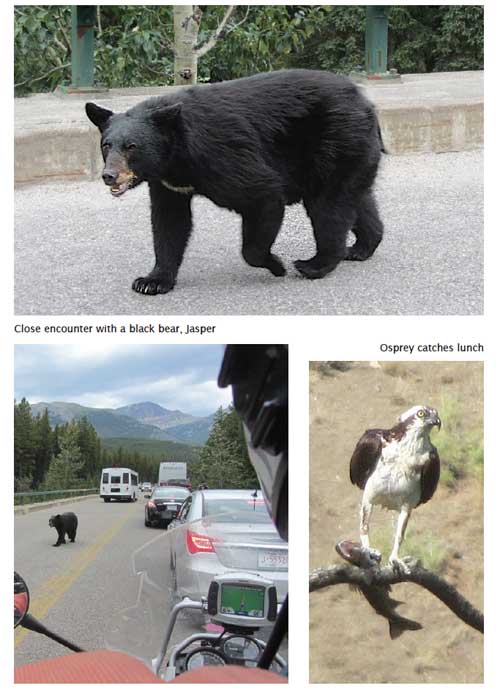
25 August – 10 September 2012
Shirley: After a sleep in we head to Tim Horton’s for breakfast. Even though it’s nearly lunchtime I think it’s probably not a good idea to have a chocolate Boston donut as my first sustenance of the day, which takes incredible will power.
We’re still not sure how to get home or when to go. One thing we are sure of is that we’ve not had enough of the local wildlife. We take the only road out of Prince Rupert, heading east to Alberta and the Rocky Mountains and through Smithers which is really jumping. The Fall Fair is on, obviously the highpoint of the season here. We don’t linger. We’ve seen enough of this town.
The camping’s not so cheap in Alberta. It costs us CAD $63.60 for two nights at the Whistler campground in the Jasper National Park. The firewood’s free but the permit to light the fire is another $8.80. We’re really getting the hang of camping. Our cooking supplies have stretched to a long-handled fork, foil, salt, pepper, spices, small olive oil and a small bottle of tomato sauce. And I’ve still got a little Vegemite left.
Even cooking over the open fire doesn’t pose too many problems. A couple of spuds in foil in the fire, tomatoes cooked in one of our mini-camping saucepans and steak cooked on the grill over the fire. Simple.
A huge elk meanders past our campsite, a massive beast. There are bears around, all the warning signs telling visitors to stay in their cars with the windows up if they see a bear in the Park. The rangers have removed a lot of the berry-bearing plants, the bears’ staple food, from the campgrounds, but they still come in looking for food. All our food and toiletries go into the bear-proof box before we turn in.

The joy of camping disappears during the night when my bed deflates — twice! Sleeping on the ground isn’t so comfy.
•
There are some beautiful lakes in Jasper. Medicine Lake baffled the First Nation people. They thought it was bad medicine because it disappears in summer and then reappears at the end of winter. What they didn’t know is that there are massive caverns under the lake that need a constant supply of water. When the melting snow and summer rains stop, the water drains into those caverns leaving the lake dry. It’s hard to imagine this massive expanse of water disappearing.
One thing that is disappearing is the caribou. There are only a few left in the Park and we don’t catch a glimpse of any of them.
By the time we get to Lake Maligne the weather’s closing in, so we don’t get to see it at its best. The dark and threatening clouds take the shine off the colour of the water. It’s time to head back to town.
There’s a traffic jam, cars backed up on both sides of the road. A lady walking past says there’s a black bear eating on the side of the road. I hop off the bike to see if I can catch a glimpse of him. And there he is, walking up the street towards us. People are hopping back into their cars as he gets near.
That’s a bit of a problem for us on the bike! We’re trapped. There’s nowhere for us to go. The bear walks within a metre of us, stops and looks and then keeps going. He just wants to eat his berries in peace. He walks behind us and wanders back into the bush. A close encounter of the bear kind!
Brian: I’m pretty sure the bear only looked at us because we’re so different to all the cars. It was a breath-holding moment when he looked our way, before wandering behind us to resume his dinner.
Camping is great, a real money saver, but it’s not fun with a flat mattress and you have to blow it up in the middle of the night. Both of our beds are leaking during the night now and I just can’t find any holes. I’ll either fix them or get rid of them.
•
The road from Jasper south to Banff is billed as ‘the world’s most scenic drive’. It’s said to be so beautiful they’ve renamed Highway 93 the Icefield Parkway.
It’s rained overnight and the clouds look oppressive this morning so we don the wets and head south through the mountains to the Columbia Icefields. There’s waterfalls galore, hanging glaciers that seem to tumble down the sides of the mountains into other glaciers. The most impressive is the Athabasca Glacier. The runoff from the glaciers creates exquisite turquoise lakes.
The most impressive of these lakes is Lake Louise, the winter playground of the rich and famous. We’re gobsmacked to read it freezes in winter. That’s mighty cold. When you see photos of Lake Louise you’d think the colours have been enhanced, but they haven’t. It’s a rich, deep green.
Closer to Banff, Highway 1, the Trans-Canada Highway, runs right through the park. To protect the animals the sides of the road are fenced and overpasses have been built for the animals to get from one side of the park to the other. There are hidden cameras on the overpasses and you can watch the animals moving about on the Trans-Canada Highway website.
Shirley: We give camping a miss so we can get a good night’s sleep in a bed that doesn’t deflate in Banff township. Brian takes the opportunity to find the leaks in our mats. It’s quite hilarious as he fills the bath and puts the mats in, trying to find the holes. There’s no plug so Brian has to stand with his foot over the plughole. It’s quite a sight. He does find a couple of small holes and patches them up. Convinced he’s fixed the problem we head out to dinner only to find both mats a little flatter when we return. More glue and more patches. The next test will be when we head back to Banff after our trip to Calgary.
Brian: Rather than the local BMW dealer, I take the bike to Anderwerks in Calgary for a service. It’s a BMW specialist without being a BMW shop so it should be a bit cheaper. The ride into the capital takes us along the Trans-Canada Highway again. There’s a family of elk drinking from a pool, safely protected by the wire fencing. It must be costly, but well worth it to protect the park’s animals.
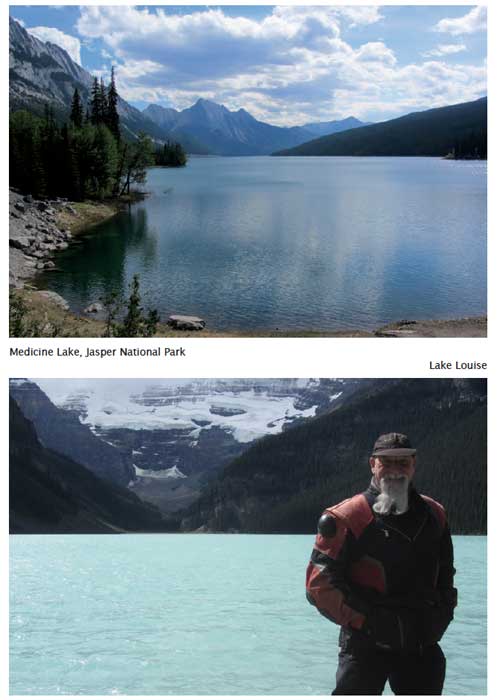
Directions have never been Shirl’s strong suit so streets that include compass points pose a real challenge. Anderwerks is on 6th Street NE which runs off 16th Avenue. Finding the avenue is easy. Shirl spots 6th Street NW so we take it, looking for the point where it becomes NE, but that doesn’t seem to exist. We waste an hour looking for it. As tempers fray we pull over to check the phone number on the email messages and ring for directions. We’re not that far away, but we’d never have found it without help. It’s in a bit of 6th Street that’s broken off by a main road.
Checking the map I see where we made our mistake. Central Ave breaks the city into NE and NW. We turned down 6th Street NW when we should’ve continued down the road a little and found 6th Street NE. It’s probably a simple system, if you know how it works.
Dave, the owner at Anderwerks, lends us his 1970s BMW to ride to the shops for lunch. Heading back it starts to splutter and spit, even when I flick the petrol over to the reserve tank. We roll into the bike shop, completely out of fuel.
The 120 kilometre ride back to Banff takes us into the Canadian Rockies and all of their splendour. There are people everywhere because it’s the Labour Day long weekend, the last break of summer, so the campgrounds are packed.
In the National Park are the Hoodoos. We’ve never heard of them and have no idea what they are until we see them. They’re very like the fairy chimneys in Turkey, pillars of rock created centuries ago by receding ice flows. From the lookout we see the Bow Falls, rapids raging deep in the valley below.
Shirley: The squirrels are very busy foraging through the pine needles for something delicious. Who needs the TV when we have this fine show right at our campsite?
Only one of the beds deflates tonight. The good news for me is that it’s Brian’s.
•
It’s wet and cold this morning when we head west to Kootenay National Park. We take the Bow Valley Parkway, a very pretty ride, even in the rain. It’s narrow and winding, perfect for us.
I’ve had to resort to the winter gloves today, my fingers are so cold. This makes using the camera virtually impossible so the wonderful mountains and cloud formations are committed to our memories’ hard drives rather than the camera.
It’s my bed that deflates this time, twice. Bloody hell, this is beyond a joke. I do say I don’t mind and I do go straight back to sleep when I blow it up again, but it’s annoying. I’m sure the only reason I wake is because my butt’s on the ground.
•
We need to head back to civilisation. Öhlins have admitted the shock shouldn’t have snapped. Apparently water got into it, causing it to seize. They’re going to replace it. We just need to tell them where to send it. We’re still not sure where we’ll end up. Whether we ship home or ride home we need to get back to the US lower 48 states. We cross the border into Montana and spend the night in Whitefish on the way to Glacier National Park. We get talking to a Harley rider at the diner and he notices me searching through all of our quarters. I explain my quarter collection and that I need one from Montana. He doesn’t have one, but the barmaid is intrigued and asks what we’re doing. She starts going through the scores of quarters in the till and the tip jar without any luck.
A young guy comes to the bar and orders a drink. She asks if he has a Montana quarter; if he does, he can have his drink for just 25 cents. He does, so I get my Montana quarter and he gets a drink for 25 cents. Everyone’s happy.
Another Harley rider at our hotel isn’t happy. He left his light on and the battery’s flat as a tack. He and Brian try and push start it, running up and down the car park. That doesn’t work. A maid has a set of jumper leads. With great difficulty, Brian pushes the leads onto the battery and holds them there and we start the bike off the car battery. We always help a fellow biker in need — it might be our turn next.
Brian: Today is the most amazing day.
From Whitefish we take the highway to West Glacier and the Glacier National Park. The Going to the Sun Road begins at Lake McDonald, a peaceful, beautiful spot. Our timing is perfect. The road closes in two weeks.
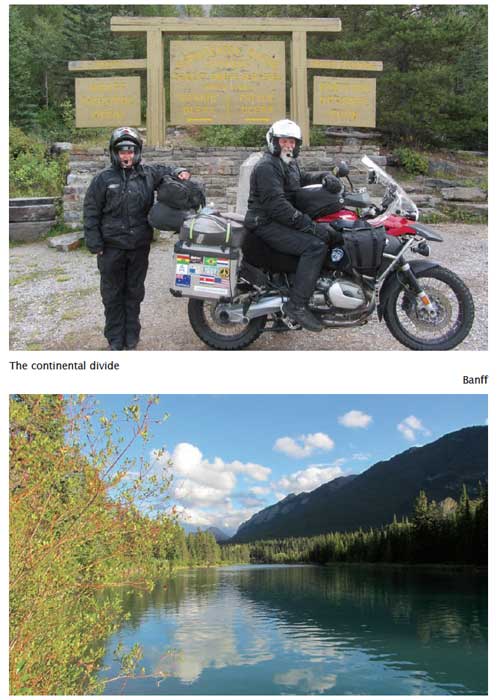
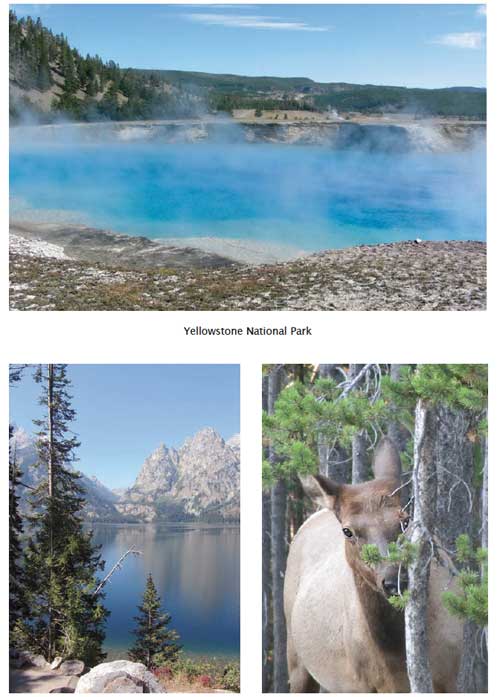
There are plenty of places to stop and enjoy the views around the lake. The reflections of the mountains and the trees are exquisite. The road takes us higher and higher to Logan Pass — the highest point at 6,646 feet. On the road up, the views across the mountains and the valleys are spectacular. This scenery is awesome. Around every corner there’s a photo opportunity. For once the road works don’t worry us (and there are plenty, as usual). The delays of 10, 15 or 20 minutes just mean we can sit and watch the scenery.
We spot a couple of bikes parked on the side of the road. The riders are using binoculars to look into the wilderness. We stop to see what they’re looking at, but they tell us they’re just looking. We pass them again on the flatlands on the eastern side of the park, but don’t stop this time.
We ride the Peace Loop around the bottom of the park, a narrow road that winds its way through the hills alongside the Flathead Range. It’s been the most amazing ride today — Going to the Sun Road is a must for any biker.
•
We need to get moving through Montana to get to Yellowstone National Park, but we don’t want to take the highways. The back roads take us to Big Fork, through the State Forest, along the Swan River and past some more amazing lakes. Summit Lake is only a small one, but it has some incredible reflections.
•
At breakfast we get talking to an older couple on a road trip. Each year they do 16,000 kilometres around the US without hitting the major highways. This will be us when we can’t or won’t ride the bike the long distances anymore!
Shirley: Inspired by the couple at breakfast we ride the small roads again today going over the Big Belt Mountains to the Lewis and Clarke Highway that takes us right into Gardiner, Montana, the northern gateway to Yellowstone National Park.
At the Iron Horse Saloon we bump into the couple with the binoculars from Glacier National Park. They show us the photos of the two families of bears they were watching when we hurtled past them. Good one Brian!
•
The ride into Yellowstone National Park is amazing. There’s an osprey in a tree with a fish in his claws, a herd of female elk with their young on the grass outside the park headquarters at Mammoth Hot Springs and massive bison grazing on the side of the road.
Ken and Carol have been camping in Yellowstone for a few days and we miss them by a couple of hours. Nic and Christian are heading our way and we’re flattered to think they’ll drive across a couple of states to enjoy the wilds of Yellowstone with us. We get a campsite that’s big enough for our tent and their Land Rover, in preparation for their arrival tomorrow.
They’re very strict here with bear boxes. We have to put EVERYTHING in it — right down to our cooking utensils and water bottles.
You can’t come to Yellowstone and not visit Old Faithful. The geyser goes off as regular as clockwork, give or take 10 minutes. About five minutes before the allocated time the steam gets higher and then we see a little water spurt out. The spurt and steam get bigger and finally — there she blows. The water bursts into the sky amidst all the steam. Then, in about 10 minutes, it’s all over. It dies down and then there’s just a simmering steam pillow again.
During the night my bed goes down twice — again.
•
We head to the Grand Teton National Park that abuts Yellowstone, travelling down the John D. Rockefeller Memorial Parkway. He donated the land to the public to ensure the land is protected. The park newspaper has a photo of a dead elk on the front page — hit by a car. This is to shock people into driving more carefully. The paper says more animals get killed on this stretch of road than anywhere else in the park.
We ride the shortish loop through the centre of the park, taking it anti-clockwise. This gives us great views of the Grand Tetons, a stark mountain range that just appears out of the ground.
The Jenny Lake loop offers up some of the most incredible reflections in calm water that we’ve seen on this trip.
At the bottom of the loop there’s Dornans, a small group of businesses established by the family during the gold rush era. The ‘chuck wagon’ was set up years ago and is still serving good food at a reasonable price.
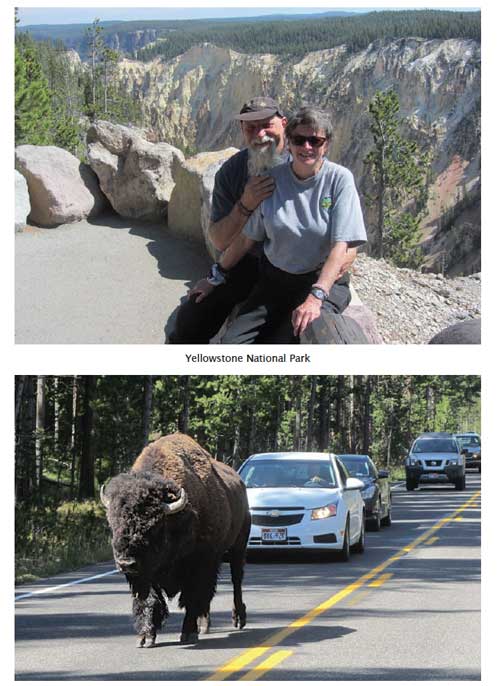
We head back to Yellowstone through desert country — flat and uninteresting, with just the odd animal.
The Land Rover is at the gate to the campground. It’s fantastic to see Nic and Christian again. We sit around the campfire and talk — old friends together again.
There are two elk does at the end of the track. They’re massive creatures. We try not to intrude on their space and have to back away when they decide they want to walk in our direction.
My bed collapses during the night yet again.
•
Brian: We head off in convoy with the Land Rover to explore Yellowstone Lake and their version of the Grand Canyon, the Yellowstone Canyon.
On the far side of the lake there’s a herd of bison. It’s magic to sit and watch them even from this distance. We can hear them bellowing and see the dust cloud as they play fight.
We have to drag ourselves away or we’ll never make it around the loop. We haven’t gone very far when there’s a traffic jam. A massive bison is walking up the road, with the traffic queuing up behind him as he plods along. He doesn’t have a care in the world and no one’s going to argue with him — he’s way too big. He seems to be enjoying the fact that he can hold up the traffic.
Virtually around the corner we come across another herd of bison with some on one side of the road and the rest of the herd on the other. These beasts are gargantuan. We’ve been warned that they can wreck a car if riled or frightened. We feel quite vulnerable sitting here, exposed on the bike, while they take their time to move across the road, just metres in front of us.
Yellowstone National Park has it all, mud volcanoes, raging rivers, massive waterfalls, hot pools, geysers, turquoise lakes and fascinating wildlife.
We don’t see any bears. It’s getting close to hibernation time and they’re eating 20,000 calories a day to prepare for the long winter sleep. Some sections of the park are closed to tourists so the bears can eat in peace.
It’s our last night with Nic and Christian and she cooks up a special dessert for our last supper — bananas with chocolate and marshmallows wrapped in foil and cooked in the coals. It might not be good for the waistline but it’s great for the taste buds.
Shirley: It’s decision time. Brian and I have been weighing up what to do now. It seems pretty clear we have two options. We can ride to Los Angeles, put the bike on a boat and fly home. Or we can ride home.
To be perfectly honest I could go home now. I’ve suffered from homesickness a lot on this trip. I miss family, friends and pets as well as the comforts of home. It’s not that I’m not having a great time. I am.
Brian: When are we ever going to get the chance to ride around the world again? We’re already half way there. It’s quite simple, really.
We can fly to the UK, ride through Europe, get the ferry to Egypt and head south. From southern Africa we can fly the bike to Perth and ride home across the Nullarbor Plain.
It’s something I’ve always dreamt of doing, and now’s the chance.
I know Shirl wants to head home, but there’s no real reason to rush. We don’t have work commitments and the family will understand.
Shirley: You win, Brian. You’re right. We’re not going to get this chance again. Instead of going west to LA we’ll head east to New York or Toronto and fly with the bike to Europe.